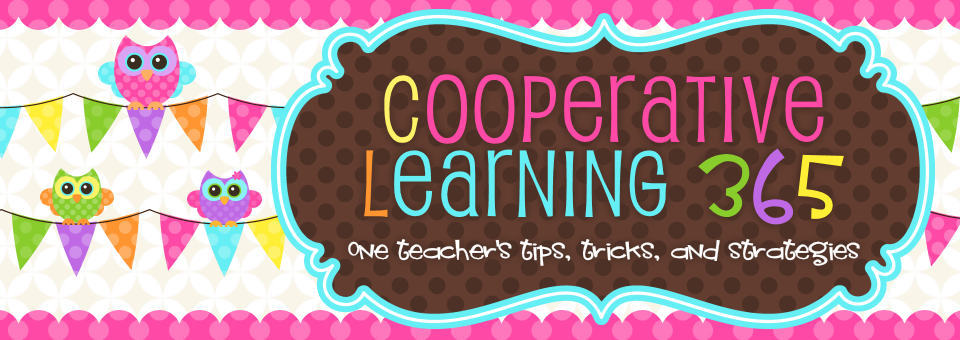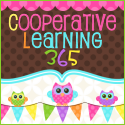1. Provide students with 4 choices: Addition, subtraction, multiplication, or division.
2. They choose which one they want to represent and provide a problem and answer.
3. Give students think time to choose their operation, and write it on a sticky note.
4. Have students give 2 or 3 problems and answers that include the operation they chose.
5. Direct students to the designated areas.
6. Once they are in their area with their sticky notes, they pair up with someone in the corner and share their thoughts. (If needed, students may make a group of three, but no more)
Thursday, September 30, 2010
Tuesday, September 28, 2010
Hot Tipz- Introducing New Structures
When introducing a new structure, I always like to introduce it with something fun. This takes less "work" for students so we can focus on the how-to-steps of the structure rather than the content. After awhile, even if students know the structure well, I like to throw in something fun for a change.
Also, I never introduce more than one structure at a time. Depending on how well my students do with the structure, determines when I teach a new structure. I have found, like teaching anything new, it varies between each group of students.
Also, I never introduce more than one structure at a time. Depending on how well my students do with the structure, determines when I teach a new structure. I have found, like teaching anything new, it varies between each group of students.

Thursday, September 23, 2010
Hot Tipz-Changing Teams
I like to change teams once a quarter. I feel like giving them nine weeks together gives them plenty of time to get to know each other and get comfortable. At times, I feel that my team configurations are so well suited for the students that I hate to change them, but even though I would like to keep my class the same, changes are necessary and beneficial for them to build new relationships.
There have been instances that I have had problems with a seating arrangement that I had to change unexpectedly. Before I move my students I always take academics into consideration along with behavior and personality. By the first couple of weeks of school, I have a great feel for how my students are and how they will interact with each other.
During the rare instances that I have had to move a student due to incompatibility, I re-evaluate the entire seating situation and take into consideration the dynamics of the other students.
Also, every quarter I keep track of my seating charts so that my teams are never the same. I even try to make it so that no two students sit at the same team all year, even though sometimes that is not possible.
There have been instances that I have had problems with a seating arrangement that I had to change unexpectedly. Before I move my students I always take academics into consideration along with behavior and personality. By the first couple of weeks of school, I have a great feel for how my students are and how they will interact with each other.
During the rare instances that I have had to move a student due to incompatibility, I re-evaluate the entire seating situation and take into consideration the dynamics of the other students.
Also, every quarter I keep track of my seating charts so that my teams are never the same. I even try to make it so that no two students sit at the same team all year, even though sometimes that is not possible.

Wednesday, September 22, 2010
Rounding Whole Numbers-Card Set
These card sets can be used a number of different ways. They can be used for Pick a Card, Ask-n-Switch, and even Show-It. After copying the card set simply cut the question out with the answer still attached. Fold the answer to the back of the question and glue.
Rounding Card Set
Rounding Card Set

Tuesday, September 21, 2010
Extending Corners
After completing a Corners exercise, add up all the students in each corner. As a class, team, or individually, create a graph based on the choices that the students made.

Sunday, September 19, 2010
Nouns-Dueling FlipCharts
1. Prompt students to think of nouns.
2. Each student writes in a different color.
3. Specify a time limit.
4. Teams line up.
5. When teacher instructs students to begin, students take turns writing down nouns.
6. Teams continue until time is up.
There are a couple of things that I include before they begin. First, I give them think time to make their own short list. This helps all students, especially the struggling students, get their thoughts organized before they begin. Next, I instruct students that they cannot write down something that has already been written down. Last, my students love a competition! My students know that at the end of the time limit we discuss their lists, and the team with the most items is the "winner".
2. Each student writes in a different color.
3. Specify a time limit.
4. Teams line up.
5. When teacher instructs students to begin, students take turns writing down nouns.
6. Teams continue until time is up.
There are a couple of things that I include before they begin. First, I give them think time to make their own short list. This helps all students, especially the struggling students, get their thoughts organized before they begin. Next, I instruct students that they cannot write down something that has already been written down. Last, my students love a competition! My students know that at the end of the time limit we discuss their lists, and the team with the most items is the "winner".

Friday, September 17, 2010
Lines of Symmetry-Four Corners
1. Give students the choice of drawing an object with exactly one, two, three, or four lines of symmetry.
2. Give students think time to write down how many lines of symmetry they want to use, and write it on a sticky note.
3. Have students draw their figure including the lines of symmetry.
4. Direct students to the designated areas.
5. Once they are in their area with their sticky notes, they pair up with someone in the corner and share their thoughts. (If needed, students may make a group of three, but no more)
2. Give students think time to write down how many lines of symmetry they want to use, and write it on a sticky note.
3. Have students draw their figure including the lines of symmetry.
4. Direct students to the designated areas.
5. Once they are in their area with their sticky notes, they pair up with someone in the corner and share their thoughts. (If needed, students may make a group of three, but no more)

Thursday, September 16, 2010
Hot Tipz- Team Numbers
Whenever possible I always have my teams set up in groups of four. In an ideal classroom that's great, teams of four, but as we all know that doesn't happen all the time. I never have a team of less than three or more than five. If I had the choice of having a team of three or five, I would say I like the team of three better. Why? Sometimes I feel like the fifth person gets left out. I like the team of three for a couple of reasons. One, I feel that buliding a relationship happens better in a smaller group. Also, I would rather have a team member doing double during a structure rather than having others sitting idle. Of course, when all is said and done, what works better for the students is what we all need to consider.

Wednesday, September 15, 2010
Commas - Fact or Fiction
Using Fact or Fiction, students write three compound sentences. In one sentence, they put the comma in an incorrect spot. In the other two sentences students put the comma in the correct place. Want to use it for a grade? Collect their papers, and you will be able to check that they can create a compound sentence correctly.

Friday, September 10, 2010
Polygon Card Set
Using Pick a Card, Ask-n-Switch, and even Show-It. The cards can be used for a review of polygons.
Polygon Cards
Polygon Cards

Wednesday, September 8, 2010
Math Facts - Fan and Pick
Pick a Card with math facts is a great alternative. We all have a set of flashcards in our classroom. They are already to use and takes no extra work from you. Pull them out for a quick review of the facts.

Wednesday, September 1, 2010
Number Forms - Four Corners
Using Four Corners
1. Provide students with 4 choices: Standard form, short word form, word form, and expanded form. They choose which one they want to represent and think of a number to give as an example.
2. Give students think time to choose the form they want to represent, and write it on a sticky note.
3. Have students give 1 or 2 examples of the number form they chose.
4. Direct students to the designated number form areas.
5. Once they are in their area with their sticky notes, they pair up with someone in the corner and share their thoughts. (If needed, students may make a group of three, but no more)
1. Provide students with 4 choices: Standard form, short word form, word form, and expanded form. They choose which one they want to represent and think of a number to give as an example.
2. Give students think time to choose the form they want to represent, and write it on a sticky note.
3. Have students give 1 or 2 examples of the number form they chose.
4. Direct students to the designated number form areas.
5. Once they are in their area with their sticky notes, they pair up with someone in the corner and share their thoughts. (If needed, students may make a group of three, but no more)

Subscribe to:
Posts (Atom)























